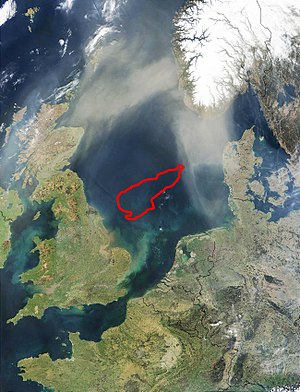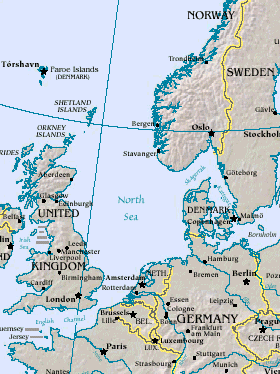|
Vikidia currently has 4,621 articles. Improve it! |
|
Join Vikidia: create your account now and improve it! |
North Sea
The North Sea is a sea in northern Europe. It is part of the Atlantic ocean. The North Sea is between Norway and Denmark in the east, Scotland and England in the west, Germany, the Netherlands, Belgium and France in the south. About 80 million people live near the North Sea, at most 150 km away from the coast. Together with the English Channel in the south, the southern North Sea is the busiest body of water in the world.
Borders[edit | edit source]
In the north-east, the Skagerrak strait (between Norway and Denmark) connects the North Sea to the Baltic Sea. In the south, the Dover Straits connects the North Sea to the English Channel, a sea between England and France.
The border between the North Sea and the Skagerrak is at an imagined line between Lindesnes in Norway, and Hanstholm in Denmark. In the North, the North sea is open towards the Atlantic. The border between the two is an imagined line from Northern Scotland, to the Shetlands, and then to Ålesund in Norway. According to the Oslo-Paris Treaty of 1962 it is a bit more to the west and the north though. The treaty puts it at 5° East longitude, and 62° North latitude. That is at the parallel of the Geirangerfjord in Norway.
Rivers that drain into it[edit | edit source]
Rivers that drain into the North Sea include: from the United Kingdom, the Tay (at Dundee), the Forth (at Edinburgh), the Tyne (Tynemouth, South Shields), the Wear (at Sunderland), the Thames, and the Humber (at Hull); from Germany : the Ems, the Elbe (at Cuxhaven), the Weser (at Bremerhaven); from Netherlands, the Rhine and Meuse or Maas (at Rotterdam), the Scheldt (at Flushing or Vlissingen);
The Kiel Canal in northern Germany, one of the world's busiest artificial waterways, connects the North Sea with the Baltic Sea.
Naming[edit | edit source]
Its name comes from its relationship to the land of the Frisians. They live directly to the south of the North Sea, and to the west of the East Sea (Oostzee, the Baltic Sea), the former South Sea (Zuiderzee, today's IJsselmeer) and the today reclaimed Middle Sea (Middelzee).
But the spread of the naming could also be from the view of the cities of the medieval Hanseatic League. Some of its main cities, like Lübeck, Bremen or Hamburg had basically the same view.
Geographic divisions[edit | edit source]

Most of the North sea is on the European Continental shelf. On average, the depth is about 93 to 94 meters only.
- In the south it is very shallow, only 25 to 35 meters and there are many sand banks. It is composed of the Southern Bight, before the coast of Belgium and the Netherlands and the German Bight before the coastline of Germany. The Dogger Bank is the limit between the southern and central parts. The Waddenzee runs all the way from Den Helder in the Netherlands to Esbjerg in Denmark.In the Dover Strait the water is about 30 meters deep.
- the central North Sea: the most shallow part of it is a sand bank called Dogger Bank with a depth between 13 and 20 metres only. The Dogger Bank covers an area about half the size of the Netherlands. The area is very famous for fishing. With some storms there are even waves breaking there.
- the northern North Sea. In the north in the bathyal zone north of the Shetlands, this depth increases to between 100 and 200 metres. The Norwegian Trench, near the Skagerrak has an average depth of around 250 to 300 metres; at the entrance to the Skagerrak, the depth increases up to 725 meters for the glacial erosion on the quaternary era. Along the trench is the Norwegian Current, which brings most of the waters of the NorthSea into the Atlantic ocean. Also, most of the waters of the Baltic Sea flow northwards here.
About 200 km east of the Scottish city of Dundee generally, the water is about 90 meters depth there . But there are many trenches, named the Devil's hole . The trenches very often are only a few kilometers in length. In these trenches, the depth increases to up to 230 meters.
Geological history[edit | edit source]
In the last ice age the North Sea was covered by large areas of ice called glaciers. About 20,000 years ago the ice melted and the North Sea was formed (made).
North Sea oil[edit | edit source]
In the 1960s geologists found large areas of oil and natural gas under the North Sea. Most of the oil fields are owned by the United Kingdom and Norway but some belong to Denmark, the Netherlands and Germany. Drilling began in the 1960s and led to an argument between England and Scotland about how the revenue (money) from the oil should be spent.
Animal life[edit | edit source]
People have been fishing in the North Sea for thousands of years. However, so many fish are now caught there that new ones may not be able to grow fast enough to keep the fishery going.
Terns, Atlantic puffins, razorbills, kittiwakes and other seabirds live on the North Sea coast. Many coastal areas are protected nature reserves.
| Geography Portal — Everything about geography, continents, regions, geology, water and climate... |

